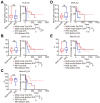A Novel Multi-Mode Thermal Therapy for Colorectal Cancer Liver Metastasis: A Pilot Study
- PMID: 35203498
- PMCID: PMC8869583
- DOI: 10.3390/biomedicines10020280
A Novel Multi-Mode Thermal Therapy for Colorectal Cancer Liver Metastasis: A Pilot Study
Abstract
A novel multi-mode thermal therapy was developed for local tumor ablation and the systemic stimulation of anti-tumor immunity, consisting of a rapid liquid nitrogen freezing, and followed by the radiofrequency heating of target tumor tissue. This pilot study aimed to compare the therapeutic effects of the new therapy with conventional radiofrequency ablation (RFA) on patients with colorectal cancer liver metastasis (CRCLM). From August 2016 to September 2019, thirty-one patients with CRCLM received either multi-mode thermal therapy (n = 17) or RFA (n = 14). Triphasic contrast-enhanced magnetic resonance imaging (MRI), routine blood tests, and peripheral blood immune responses were evaluated before the treatment and in 1, 3, 6, and 12 months after. Local tumor response and progression-free survival (PFS) were assessed using the Kaplan-Meier method, and pre- and post-treatment immune cell counts were analyzed using Mann-Whitney U and Wilcoxon tests. A significantly longer PFS was observed in the multi-mode thermal therapy group in comparison to that of the conventional RFA group (median, 11.4 versus 3.4 months, p = 0.022). It was found that multi-mode therapy induced the functional maturation of dendritic cells, promoted CD4+ T cell-mediated antitumor responses, and decreased regulatory T cells, contributing to better therapeutic efficacy in CRCLM patients.
Keywords: colorectal cancer liver metastasis; multi-mode thermal therapy; thermal immune response.
Conflict of interest statement
The authors declare no conflict of interest.
Figures






Similar articles
-
Thermal Ablation of Colorectal Lung Metastases: Retrospective Comparison Among Laser-Induced Thermotherapy, Radiofrequency Ablation, and Microwave Ablation.AJR Am J Roentgenol. 2016 Dec;207(6):1340-1349. doi: 10.2214/AJR.15.14401. Epub 2016 Sep 28. AJR Am J Roentgenol. 2016. PMID: 27680945
-
Neoantigen-specific CD4+ T-cell response is critical for the therapeutic efficacy of cryo-thermal therapy.J Immunother Cancer. 2020 Sep;8(2):e000421. doi: 10.1136/jitc-2019-000421. J Immunother Cancer. 2020. PMID: 32938627 Free PMC article.
-
Salvage RFA in patients with intrahepatic recurrence after major hepatic surgery for colorectal cancer liver metastases: mid-term outcome.Eur Radiol. 2020 Feb;30(2):1221-1227. doi: 10.1007/s00330-019-06421-3. Epub 2019 Sep 6. Eur Radiol. 2020. PMID: 31493210
-
Role of thermal ablation in the management of colorectal liver metastasis.Hepatobiliary Surg Nutr. 2020 Feb;9(1):49-58. doi: 10.21037/hbsn.2019.06.08. Hepatobiliary Surg Nutr. 2020. PMID: 32140478 Free PMC article. Review.
-
Radiofrequency ablation of liver metastasis: potential impact on immune checkpoint inhibitor therapy.Eur Radiol. 2019 Sep;29(9):5045-5051. doi: 10.1007/s00330-019-06189-6. Epub 2019 Apr 8. Eur Radiol. 2019. PMID: 30963271 Review.
Cited by
-
Exploration of the impact of multimode thermal therapy versus radiofrequency ablation on CD8+ T effector cells of liver malignancies based on single cell transcriptomics.Front Immunol. 2023 Jun 2;14:1172362. doi: 10.3389/fimmu.2023.1172362. eCollection 2023. Front Immunol. 2023. PMID: 37334386 Free PMC article.
-
Immune dynamics shaping pre-metastatic and metastatic niches in liver metastases: from molecular mechanisms to therapeutic strategies.Mol Cancer. 2024 Nov 14;23(1):254. doi: 10.1186/s12943-024-02171-z. Mol Cancer. 2024. PMID: 39543660 Free PMC article. Review.
-
Combining all-trans retinoid acid treatment targeting myeloid-derived suppressive cells with cryo-thermal therapy enhances antitumor immunity in breast cancer.Front Immunol. 2022 Nov 1;13:1016776. doi: 10.3389/fimmu.2022.1016776. eCollection 2022. Front Immunol. 2022. PMID: 36389684 Free PMC article.
-
IFNγ at the early stage induced after cryo-thermal therapy maintains CD4+ Th1-prone differentiation, leading to long-term antitumor immunity.Front Immunol. 2024 May 17;15:1345046. doi: 10.3389/fimmu.2024.1345046. eCollection 2024. Front Immunol. 2024. PMID: 38827732 Free PMC article.
-
Th1-Dominant CD4+ T Cells Orchestrate Endogenous Systematic Antitumor Immune Memory After Cryo-Thermal Therapy.Front Immunol. 2022 Jul 8;13:944115. doi: 10.3389/fimmu.2022.944115. eCollection 2022. Front Immunol. 2022. PMID: 35874660 Free PMC article.
References
-
- Ostberg J.R., Dayanc B.E., Yuan M., Oflazoglu E., Repasky E.A. Enhancement of natural killer (NK) cell cytotoxicity by fever-range thermal stress is dependent on NKG2D function and is associated with plasma membrane NKG2D clustering and increased expression of MICA on target cells. J. Leukoc. Biol. 2007;82:1322–1331. doi: 10.1189/jlb.1106699. - DOI - PubMed
Grants and funding
LinkOut - more resources
Full Text Sources
Research Materials

